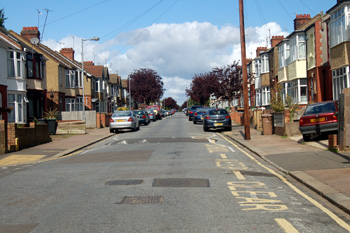Luton in the Dark Ages

A cinerary urn from Argyll Avenue - from William Austin's History of Luton
The Romans eventually left Britain, in 410AD. The period between this date and the Norman Conquest of 1066 was traditionally called the Dark Ages as, unlike the Classical World, there was perceived to be a paucity of written material available to shed light these 650 or so years. Today the term has largely fallen out of favour with historians for a number of reasons, not least the information now available from archaeology. Nevertheless the term still means something in most people's minds whereas the term Early Medieval is, for most people, less well defined.
Luton has a considerable number of finds and sites associated with the Dark Ages which may be broken down into three types: excavated settlement sites; excavated burial sites and finds. The Bedfordshire Historic Environment Record [HER] lists these and is the source for this article.
Excavated Settlement Sites
Redevelopment work in Luton town centre about 1970 revealed a small area of dark soil some 6 feet long by 4 feet wide and about half an inch deep on the Church Street side of the site, directly opposite the North gate of St. Mary's churchyard. The feature which appeared to be the floor of a small building yielded a few sherds of Early Medieval (i.e. pre-1066) pottery. The feature was almost rectangular in shape, lying at an angle of 45 degrees to the line of Church Street [HER 11950].
Small scale excavations at Black Swan Lane produced evidence for occupation in the Roman and Anglo-Saxon periods. Residual pottery provided the main evidence for Saxon and Roman occupation although a post pit and a set of bronze tweezers, both of which can be dated to the 2nd-3rd century, support the period of Roman activity [HER 15290].

Argyll Avenue September 2009
Excavated Burial Sites
Two or three (records are unclear) Anglo-Saxon burials were found in 1903 near the railway at Leagrave Common. The skeletons were in a contracted position. The skeletons were accompanied by two pairs of disc brooches, a thickly gilded bronze disc, a stylus, a fragment on ivory armlet and a pin of "Klapperschmuck" type, with spangles attached to the head. The burials dated from the mid to late 6th century [HER 200]. Two burials were found in 1905 west of Waulud's Bank. The contracted inhumations were found with brooches, pendant, decorative pin, stylus and part of an ivory armlet. The grave goods were taken to the British Museum and the skeletons were reburied at Biscot [HER 823].
Building work at Argyll Avenue in 1925 revealed an extensive Anglo-Saxon cemetery [HER 178]. It contained forty five inhumations (burials) and eight cremations and a large quantity of grave goods was recovered. These included sixteen spears, twenty two knives, a sword, eight shield bosses, thirty five brooches of various types, and three festoon necklaces of glass and amber beads, one with pierced Roman coins at either end. Some of the cremation vessels were decorated. The burials were a mixture of adults (both men and women) and children, unlike those at nearby Biscot Mill, for which see below. The Argyll Avenue burials were also more richly furnished than those at Biscot Mill and apparently of a slightly earlier date. The Argyll Avenue burials appear to be predominantly 6th century AD in date but some finds could be as early as the mid-fifth century, or as late as the early 7th.
A number of burials have been found in the area of Biscot Mill since the mid 19th century. The main group have been found since 1923 and comprise remains of thirteen individuals, some with grave goods [HER 2842]. Where identifiable, all adults were male. One burial was a juvenile. A total of four spearheads and four knives were found, along with a shield boss and an arrowhead, leading to suggestions that this was a cemetery specifically for men. It was at first thought to be part of the cemetery at Argyll Avenue [see above] but is now thought to be later in date, probably 7th century AD. The two cemeteries are quite distinct and no burials have been found in the area between them.
The burial of a Saxon woman was found in 1930, by a workman digging just inside the gates of the CWS cocoa factory in Dallow Road. The remains were in a grave roughly cut into the natural chalk. The grave goods consisted of a pair of iron shears and a cowrie shell, possibly from the Indian Ocean [HER 181]. A burial was found in 1940 at Beechwood Road. The skeleton had been buried with an iron knife as the only accompanying grave goods. It has been regarded as a Saxon burial although without any qualifying evidence [HER 171]. Another single burial was found during pipe laying work in 1953 in Sarum Road. The skeleton was female, buried with the head to the east, with grave goods comprising a bone comb held together with iron pins, and an iron knife. The finds are now in Luton Museum [HER 169].
Finds
Finds recorded by the Bedfordshire Historic Environment Record include the following:
- A grooved spearhead with an unusual shaft, dating from the 5th to 8th centuries, was found at Waters Lane, in the foundations of a new bridge in 1923 [HER 199];
- A sherd of Anglo-Saxon pottery was found in Leagrave in 1898 [HER 784];
- A 20 carat gold filigree "button" of an Anglo-Saxon date was uncovered at Burford Close. The button was declared treasure trove due to its date and having a gold percentage of 89%. It was probably an ornament for clothing as opposed to serving a practical function as a button [HER 18115].